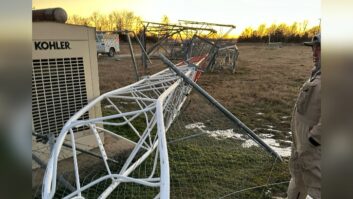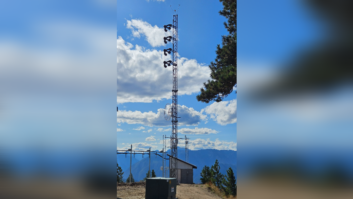Is the Outcry Over Bird Tower-Kills an Issue of Ecological Preservation or Desirable Aesthetics?
Some time ago, I penned a guest editorial sharing the experience spending my younger years in the shadow of what has come to be known as the worse bird tower-kill incident in recorded history (“The Myth of the Tower-Kill Bird Massacre,” Feb. 1, 2003).
To be fair, there probably was a real incident; but as I mathematically proved, to my satisfaction anyway, there was also more than a fair amount of exaggeration in the retelling by those dedicated to preserving the avian population.
Maybe as many as a hundred songbirds were killed one foggy 1974 night in Eau Claire, Wis. That morphed into tens of thousands of much larger birds in the retelling. Where exaggeration becomes untruth I am not willing to say. The world needs a tall tale or two. Eau Claire is the home of the Paul Bunyan logging camp, after all, and the Great Lakes are his footprints.
Still, we don’t make public policy based on the footprint story.
Burden of proof
With WT Docket 03-187, the FCC is again going back to the birds, seeking public comment on a preliminary report from Avatar Environmental that equates tower heights, lights and poor seeing conditions with migratory bird tower kills, but fairly notes that more is unknown than known. Avatar is a small Pennsylvanian firm that does environmental approval work, and prepares Environmental Impact Statements (EIS) as a business.
The site points to their broad expertise, but there are no supporting résumés of staff or specific claims posted that I can find. Okay, that kind of specificity is more an engineering thing.
The company has been in business since 1999 and lists 11 projects and 12 risk assessments. From the lists, one might conclude this is its first involving the FCC and towers, though wetlands – and, I presume, birds – are claimed proficiencies. In all honesty, this is probably the right-sized firm with the right kind of mission for this analysis, and while there are “tower” and “bird” experts, I am unaware of anyone with proficiencies in both, unless it is something a group like Avatar can master.
If bird kills are as rare as broadcast engineers seem to think – or rather fail to observe – then gathering statistically significant data is going to require a good deal of resources and a healthy sample pool and period.
The few ornithologists with whom I have spoken will agree, without attribution, that inspecting a hundred towers every day for a year is statistically unlikely to produce evidence of a mass kill, though guesses as to how many individual kills might be detected vary from a few dozen (towers act like a big screen door model) to thousands (something attracts birds to die at towers, the www.towerkill.com hypothesis).
But that is why the FCC contracted Avatar to determine the answer. Done right, this can be good. Absolutely nothing less than first-hand statistical data, with photos and bodies, is required – or I’ll write another editorial.
I did receive a fair amount of response from that last editorial. Lots of laughs and applause from the broadcast engineering side, and some moral indignation from others; I received pictures of towers without dead birds but not one with a dead bird. On www.towerkill.com , they have several maps of towers, but no pictures. Because broadcast engineers who spend time at towers generally have not seen a large number of birds killed by the tower, whatever evidence they offer must be considered biased.
If there is a conspiracy in broadcast engineering, this must be it.
Restoring nature or aesthetics?
Somewhere, somehow, sometimes, birds fly into towers and die. Second, killing any living creature has its critics; though many feel that animals killed for food or to stop the spread of disease, or ones that look ugly like insects and spiders and snakes, might not deserve the same level of protection.
Tower kill stories seem to center on songbirds. Had these been buzzards or seagulls, or SARS- or influenza-carrying birds, opinions would likely vary.
Bottom line, we can agree that birds hitting towers is worse than birds not hitting towers. But we have no idea how to fix it, short of taking down the towers. One would think bird watchers and lovers would be visiting each tower every morning with a camera and click-counter; and the mass of statistical evidence would point to the combinations of lights, heights, widths, locations, etc., to avoid; and the tower industry would responded by testing tower mount scarecrows, hypersonic whistles and covering towers with bubble wrap and pie tins.
Our society has simply failed to respond at this level, as obvious a threat to the ecology as it might be.
Let’s grant that this has nothing to do with our society suddenly finding towers unsightly – and SUVs and Mc Mansions on unstable and fire prone hillsides very alluring and desirable – but rather with restoring the very balance of nature.
With that said, let me propose a solution. In a similar situation, we offer pollution credits, with the concept being that a power plant that finds it expensive to remove pollutants can pay another industry where the same pollutant can be reduced more economically. In the end, the problem pollution is reduced as desired, and with the desirable economies of the free market.
Few doubt that cats eradicate more birds than towers. The question is, how many more? Estimates suggest that fatality by cat is somewhere between 1,000 and 10 million times more likely for a given bird than demise by tower. Likewise, we hunt certain migratory birds, poison certain unpleasant birds and give kids BB guns.
If this is truly about restoring the balance of nature, I suggest the radio industries fund certain bird-credits to offset and maybe even reduce bird casualties beyond the havoc triggered by towers. If as an industry we promote and underwrite bird-bells for cats (worn by a cat, a bird-bell alerts birds of a predatory approach), and provide other credits such as buying back migratory bird hunting licenses (season football tickets in trade for a hunting license?), we can probably reduce bird mortality more dramatically than simply taking down towers.
Likewise, as an industry, we need to take this seriously. If every engineer took a camera and walked around the tower or checked a better sample area like the roof on every daylight transmitter visit, we could collect the statistical data necessary to determine what tower conditions result in mass bird eradications – and broadcast engineers would be healthier for the exercise. That knowledge would enable intelligent and necessary modifications to reduce tower kills.
Of course, if this is really about getting rid of unsightly towers, and not saving birds, the FCC will have less interest in this proposal than they do in community broadcasting. The truth is out there, and we’d like to know what it is.












